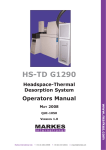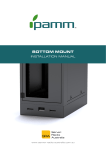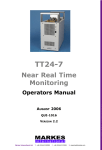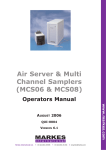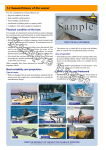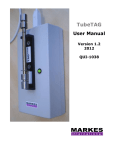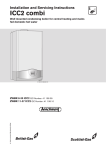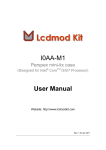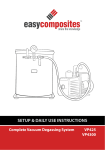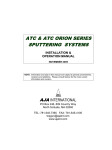Download Ultra manual v3.0.qxd
Transcript
HS-TD G1888 User Markes International HS-TD G1888 Headspace-Thermal Desorption System Operators Manual January 2011 www.markes.com QuI-1043 VerSIOn 1.2 Markes International Ltd. T: +44 (0) 1443 230935 F: +44 (0) 1443 231531 E: enquiries@markes.com HS-TD G1888 User Manual Markes International www.markes.com This page left intentionally blank QuI-1043 V1.2 Jan 2011 Markes International Ltd. T: +44 (0) 1443 230935 F: +44 (0) 1443 231531 E: enquiries@markes.com HS-TD G1888 User Manual Markes International Table of Contents 1. Introduction 4 2. Packing List 4 3. Installing unITy(e) onto G1888 headspace system 4 4. Software Instructions 13 5. Operation 15 Table of Figures PTFE block with aluminium tube inserted 4 Figure 2. UNITY-HS link tube assembly 5 Figure 3. Link tube inserted into PTFE block 5 Figure 4. Connecting the HS transfer line to the inert zero dead volume union 6 Figure 5. Secure the transfer line into the PTFE block 6 Figure 6. Fit the Perspex cover supplied 7 Figure 7. Extending the carrier gas inlet line 7 Figure 8. Removing the HS valve cover 8 Figure 9. Removing the black needle cover 8 Figure 10. Removing the silcosteel tubing 9 Figure 11. Removing the silcosteel tubing from the 6 port valve. 9 Figure 12. Connecting 1/16 inch Silcosteel tubing 10 Figure 13. Position sample outlet line vertically 10 Figure 14. Connecting the sample outlet line 11 Figure 15. Connecting up the Valco T-piece 11 Figure 16. Connect the UNITY line into the T-piece 12 Figure 17. Gas line protruding from HS system 12 Figure 18. UNITY “Options” menu, displaying selection to operate direct mode with with HP 7694 14 Figure 19. UNITY operating software displaying status of HS system 15 Figure 20. Method parameter window for controlling HS sampler 16 QuI-1043 V1.2 Jan 2011 Markes International Ltd. -3- T: +44 (0) 1443 230935 F: +44 (0) 1443 231531 E: enquiries@markes.com www.markes.com Figure 1. HS-TD G1888 User Manual Markes International 1. Introduction Markes International’s HS-TD system brings together two of the most powerful GC introduction techniques: equilibrium headspace (HS) and thermal desorption (TD). The combined system offers users optimum sensitivity for trace VOCs in solid, liquid and vapour-phase samples - all on one, versatile analytical platform. This manual gives details of the Markes HS-TD system for the following models: Agilent G1888 headspace system Markes UNITY(e) thermal desorption system 2. Packing List Remove the contents from the shipping box, inspect and check each item against the Packing List included with the order. Retain the instrument packaging and reuse if ever the system is to be shipped using conventional carriers. 3. Installing unITy(e) onto G1888 headspace system Take the aluminium tube (p/n SERUTD-1384) and insert into the PTFE collar (p/n SERUTD-1229). Also insert the three screws supplied (p/n SERZM416PPSS) into the PTFE block as shown in figure 1. PTFe Collar Figure 1: PTFE collar with aluminium tube inserted QuI-1043 V1.2 Jan 2011 Markes International Ltd. -4- T: +44 (0) 1443 230935 F: +44 (0) 1443 231531 E: enquiries@markes.com www.markes.com aluminium tube inserted inside PTFe collar HS-TD G1888 User Manual Markes International Take the UNITY-HS link tube assembly (p/n SERUTD-5132) (figure 2) and insert the end with the zero dead volume silcosteel union attached, into the PTFE collar as shown (figure 3). unITy Link tube Brass sleeve Zero dead volume union Figure 2: UNITY-HS link tube assembly unITy Link tube PTFe collar Zero dead volume union Insert the link tube into UNITY (with the PTFE collar to the back of the system), but do not seal the link tube into place. Connect the HS transfer line into the union as shown (figure 4). QuI-1043 V1.2 Jan 2011 Markes International Ltd. -5- T: +44 (0) 1443 230935 F: +44 (0) 1443 231531 E: enquiries@markes.com www.markes.com Figure 3: Link tube inserted into PTFE collar HS-TD G1888 User Manual Markes International Figure 4: Connecting the HS transfer line to the inert zero dead volume union ow secure the transfer line into the PTFE collar using the three screws as shown (figure 5). Seal the UNITY link tube into the UNITY oven and fit the Perspex cover supplied (p/n SERMTD-1368) onto UNITY as shown (figure 6). QuI-1043 V1.2 Jan 2011 Markes International Ltd. -6- T: +44 (0) 1443 230935 F: +44 (0) 1443 231531 E: enquiries@markes.com www.markes.com Figure 5: Secure the transfer line into the PTFE collar HS-TD G1888 User Manual Markes International Figure 6: Fit the perspex cover supplied Connect the 1/16 inch stainless steel union supplied (p/n SERZ-0386) to the carrier gas inlet tube on the UNITY link tube. Then connect the 500 mm piece of 1/16 inch stainless steel tubing supplied (p/n SERZ-0175) to the union in order to extend this inlet gas line (figure 7). Open the top cover of the HS unit, and remove the stainless steel cover over the valve system by loosening the two screws and lifting off the cover (figure 8). QuI-1043 V1.2 Jan 2011 Markes International Ltd. -7- T: +44 (0) 1443 230935 F: +44 (0) 1443 231531 E: enquiries@markes.com www.markes.com Figure 7: Extending the carrier gas inlet line HS-TD G1888 User Manual Markes International Figure 8: Removing the HS valve cover Unscrew the screw and remove the black cover over the headspace needle, to expose the silcosteel union (figure 9). Remove the silcosteel tubing from the union as shown (figure 10). QuI-1043 V1.2 Jan 2011 Markes International Ltd. -8- T: +44 (0) 1443 230935 F: +44 (0) 1443 231531 E: enquiries@markes.com www.markes.com Figure 9: Removing the black needle cover HS-TD G1888 User Manual Markes International Figure 10: Removing the silcosteel tubing Also remove the silcosteel tubing from the 6-port headspace valve and retain for use if you wish to return to standard headspace operation in the future. Connect the 170 mm length of 1/16 inch silcosteel tubing supplied (p/n SERZ-0679) to the headspace needle and feed through as shown in figure 12. QuI-1043 V1.2 Jan 2011 Markes International Ltd. -9- T: +44 (0) 1443 230935 F: +44 (0) 1443 231531 E: enquiries@markes.com www.markes.com Figure 11: Removing the silcosteel tubing from the 6 port valve HS-TD G1888 User Manual Markes International Figure 12: Connecting 1/16 inch silcosteel tubing Remove the HS fitting which connects the 6-port valve to the HS transfer line and position the sample outlet line in a vertical position as shown (figure 13). Connect 100 mm length of 1/16 inch silcosteel tubing supplied (p/n SERZ-0679) to the zero dead volume connector (p/n SERZ-0691) and connect this union to the sample outlet line as shown (figure 14). QuI-1043 V1.2 Jan 2011 Markes International Ltd. -10- T: +44 (0) 1443 230935 F: +44 (0) 1443 231531 E: enquiries@markes.com www.markes.com Figure 13: Position sample outlet line vertically HS-TD G1888 User Manual Markes International Figure 14: Connecting the sample outlet line Connect both the lengths of 1/16 inch silcosteel tubing connected above, into the silcosteel zero dead volume Valco T-piece (p/n SERZ-0699) as shown in figure 15. Connect the 1/16 inch stainless steel tubing from the UNITY link tube into the Silcosteel T-piece as shown (figure 16). QuI-1043 V1.2 Jan 2011 Markes International Ltd. -11- T: +44 (0) 1443 230935 F: +44 (0) 1443 231531 E: enquiries@markes.com www.markes.com Figure 15: Connecting up the Valco T-piece HS-TD G1888 User Manual Markes International Figure 16: Connect the UNITY line into the T-piece Replace the black needle cover over the Headspace needle connection and the metal cover over the headspace valve system. Finally feed the carrier gas inlet line to the front right hand corner of the Headspace unit and carefully shut the headspace cover taking care to ensure that the cover does not crimp the gas line (figure 19). QuI-1043 V1.2 Jan 2011 Markes International Ltd. -12- T: +44 (0) 1443 230935 F: +44 (0) 1443 231531 E: enquiries@markes.com www.markes.com Figure 17: Gas line protruting from HS system HS-TD G1888 User Manual Markes International This completes all the flow path connections. To leak test the system, place an empty headspace vial into position 1 in the G1888 and set to “Inject” with a long sampling time (sufficient to allow full leak testing). Use the UNITY “Leak test” dialogue, to pressurise the system and test for leaks. 4. Software Instructions Prior to installing software, the Headspace system should be connected via a LAN cable to the network, and a spare IP address should be available. using the HSS menu function: Check Lan settings Sub net mask must be the same as on the operating PC. This can be checked on the PC by doing the following: Click on ‘Run’ from the Start menu Type CMD in the box When command prompt is launched, type in “ipconfig /all” The subnet mask will be displayed. Installing s/w Load CD and copy folder to Program directory on PC. Open executable file Agilent G1888.exe This will open the HSS operating software. Connecting to HS Setting up unITy for operation with G1888 HS system Select the “Unity.opt” file, in the UNITY program folder. Open this file using notepad. In this text file, change the following lines: Direct = off should be changed to Direct = on Syncstatdisplay = Probe in should be changed to Syncstatdisplay = start sampling Save the changes to this file, close, and restart UNITY. QuI-1043 V1.2 Jan 2011 Markes International Ltd. -13- T: +44 (0) 1443 230935 F: +44 (0) 1443 231531 E: enquiries@markes.com www.markes.com Select TCP/IP from the “remote” menu. This will open a TCP/IP Connection window. Insert the IP address that you will be running the HSS from. Click connect. The TCP status should change from yellow to green, and state online. HS-TD G1888 User Manual Markes International From the View>Options menu, select the configuration tab. Tick the box which says operate direct mode with HP7694. Close software. Open HS operating software and connect to the unit as above. Open UNITY s/w When you select Direct sampling from the drop down menu, a new window should appear which says HP7694DDE. This completes the software installation and setup. Figure 18: UNITY “Options” menu, displaying selection to operate direct mode with HP 7694 Markes International Ltd. www.markes.com QuI-1043 V1.2 Jan 2011 -14- T: +44 (0) 1443 230935 F: +44 (0) 1443 231531 E: enquiries@markes.com HS-TD G1888 User Manual Markes International Figure 19: UNITY operating software displaying status of HS system 5. Operation 5.1. Headspace settings The HS parameters are controlled via the “Method Parameter” window in the G1888 controlling software (see figure 20). Markes International Ltd. www.markes.com QuI-1043 V1.2 Jan 2011 -15- T: +44 (0) 1443 230935 F: +44 (0) 1443 231531 E: enquiries@markes.com HS-TD G1888 User Manual Markes International Figure 20: Method parameter window for controlling HS sampler Oven Sample Valve Transfer line Controls temperature of HS vial oven Controls temperature of sample valve Controls temperature of HS transfer line GC Cycle Sets interval between runs to allow overlap of samples. For HS-TD operation, the total GC cycle time should be calculated as follows: GC runtime + GC equilibration (cooldown) time + HS injection time time Not Not Not for equilibration of vial in HS oven used in HS-TD operation used in HS-TD operation used in HS-TD operation Injection time: Sets the time for which the HS needle is inserted into the vial to allow sampling. This is calculated from the UNITY method conditions, and is the total of all purge times and direct sampling times: (Note: if multiple extractions are being carried out, it is important to calculate the correct total time for direct sampling) Vial Parameters: QuI-1043 V1.2 Jan 2011 Markes International Ltd. Sets the sequence of vials to be sampled -16- T: +44 (0) 1443 230935 F: +44 (0) 1443 231531 E: enquiries@markes.com www.markes.com Vial equilibration: Sets Vial pressurization: Loop fill time: Loop equilibration: HS-TD G1888 User Manual Markes International 5.2. unITy settings Note: Dynamic direct sampling involves a continuous flow of carrier gas through (or from) the sample vessel sweeping the headspace vapours into the UNITY cold trap for a defined period of time and is not compatible with single needle headspace systems. Pulsed direct sampling works by pressurising a sealed sample vessel for a set period of time and then shutting off the gas supply and allowing the carrier gas pressure to be released out through the cold trap of UNITY. This process may be repeated multiple times on a single sample to enhance the concentration of trapped analytes before desorbing the cold trap and beginning the GC(/MS) analysis. Pulsed direct sampling is thus compatible with a single inlet/outlet point and can therefore be used with single needle headspace systems Sampling parameters Prepurge: Prepurge pressurises the sample vessel and cleans out the sampling lines thus helping prevent carryover from previous runs and sweeps any air out of the flow path. However, as there is no overall flow in the sampling vessel prepurge does not flush the vessel. Prepurge therefore defines the time for which gas sweeps through the sample lines and into UNITY through the flow-path bypassing the trap and out through the split at the flow rate set on the split needle valve Pressurisation time: When set to zero UNITY runs in dynamic direct sampling mode. Sampling time: Defines the amount of time for which the solenoid valve downstream of the cold trap is opened so that sample is transferred from the sample vessel to the cold trap. The pressure drops as soon as sampling begins until it eventually reaches atmospheric pressure. QuI-1043 V1.2 Jan 2011 Markes International Ltd. -17- T: +44 (0) 1443 230935 F: +44 (0) 1443 231531 E: enquiries@markes.com www.markes.com When set to any non-zero value UNITY will run in pulsed rather than dynamic direct sampling mode. When in pulsed sampling mode this defines the time for which carrier gas is supplied to the sample vessel to build up pressure prior to releasing that pressure through the cold trap. HS-TD G1888 User Manual Markes International equilibration time: Governs the amount of time for which the sample in the sampling vial is allowed to re-equilibrate before it is repressurised and resampled. Sampling cycles: Sets the number of times that the pressurisation, sampling and equilibration steps will be repeated for any particular sample, before desorption of the focusing trap triggers the GC(/MS) analysis. Flush time: A similar step to Prepurge, this stage permits carrier gas purge of the sample lines to remove any residual sample and transfer to the trap or out of the split or both. Trap Purge: Defines the time for which carrier gas is purged through the cold-trap in the sampling direction. This procedure purges the trap of any oxygen prior to heating and, under certain conditions, allows selective purge of unwanted volatiles such as water or ethanol. GC Cycle The GC cycle time should be set to 0.1 for all HS-TD operations. Markes International Ltd. www.markes.com QuI-1043 V1.2 Jan 2011 -18- T: +44 (0) 1443 230935 F: +44 (0) 1443 231531 E: enquiries@markes.com


















